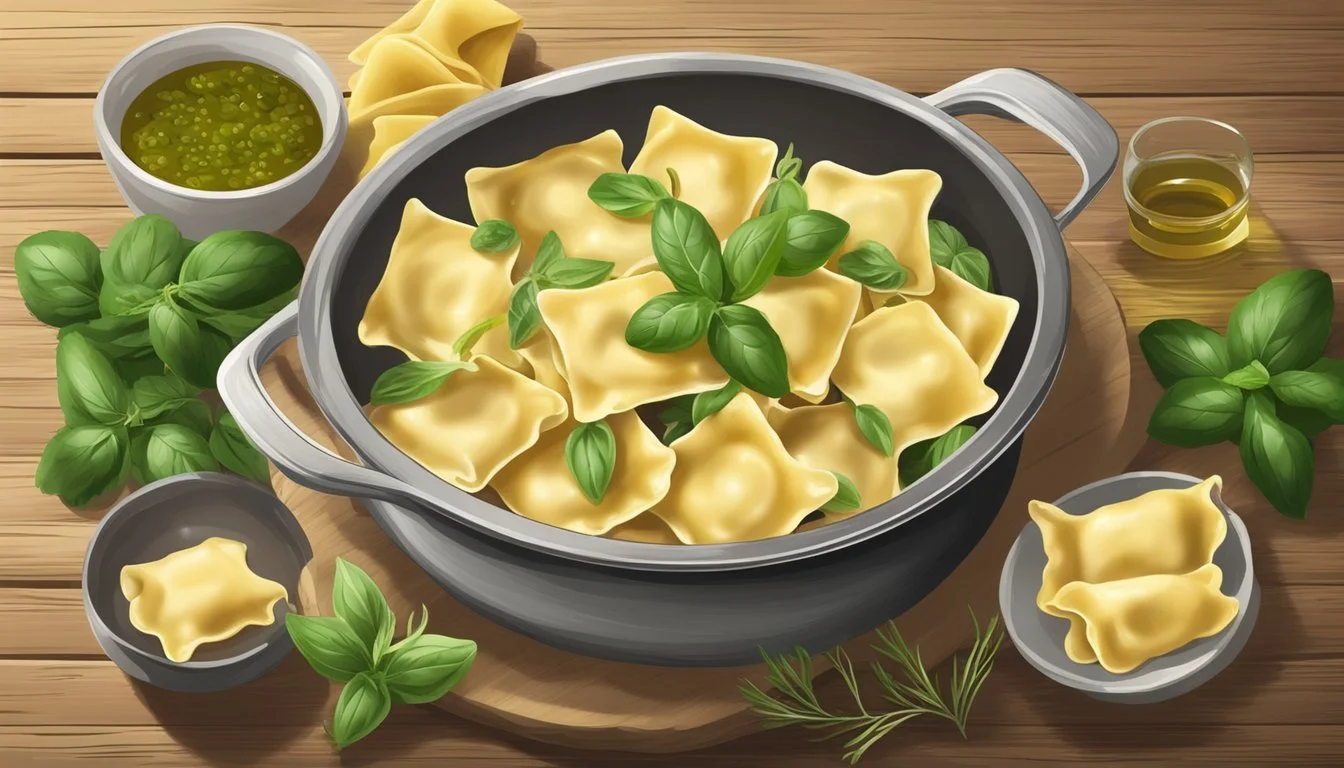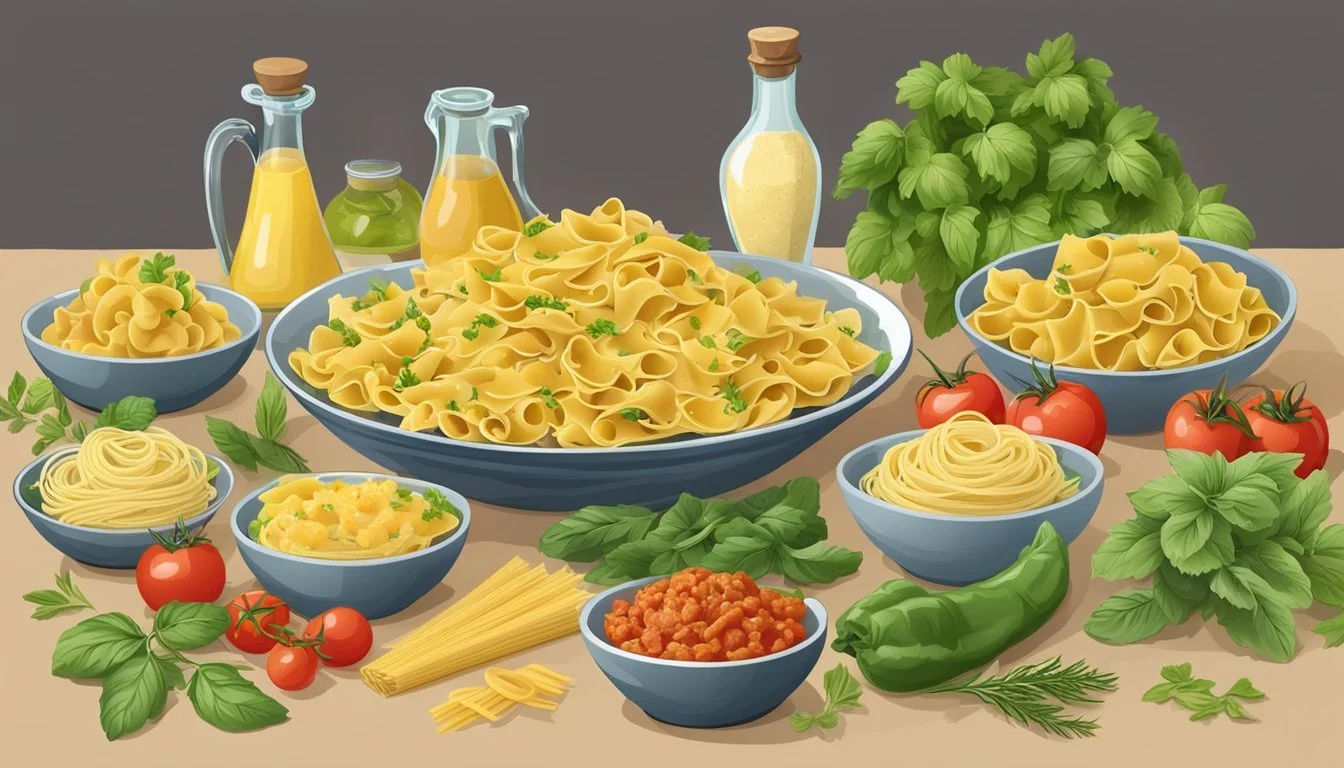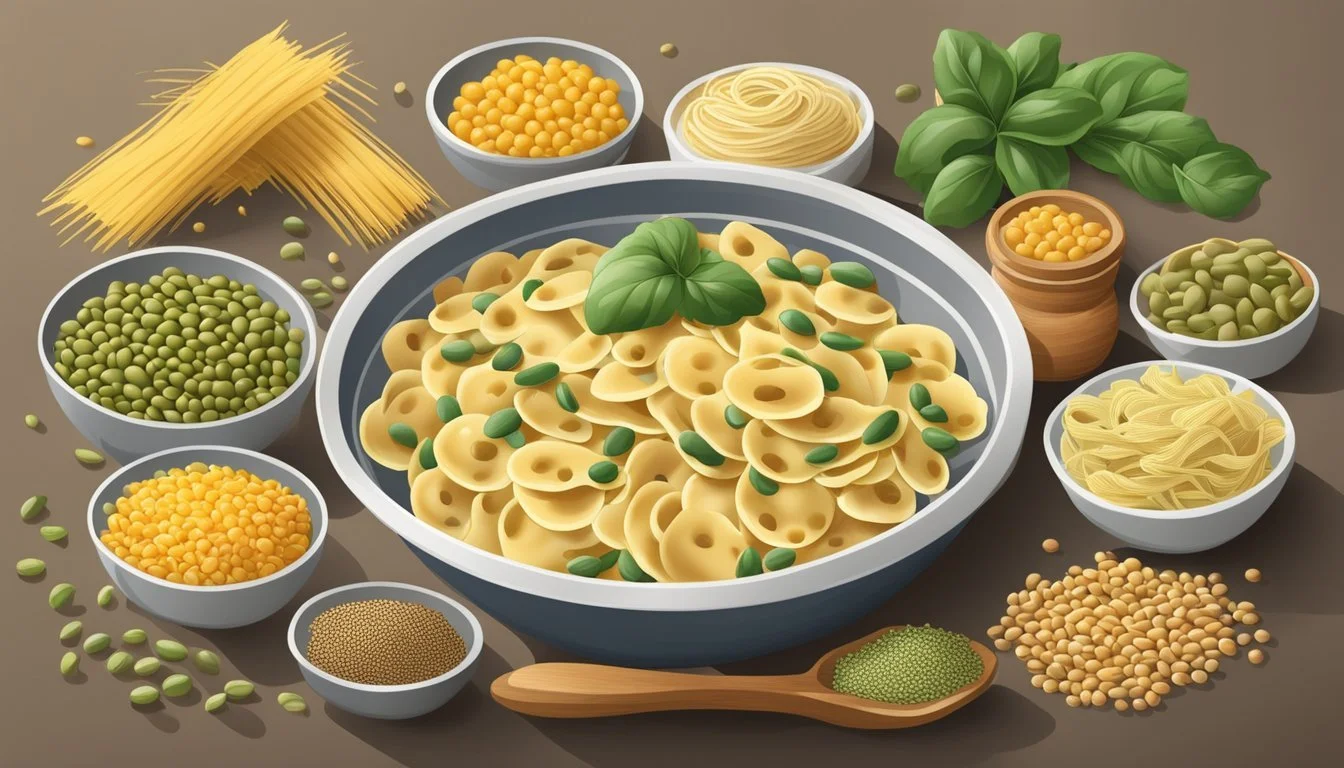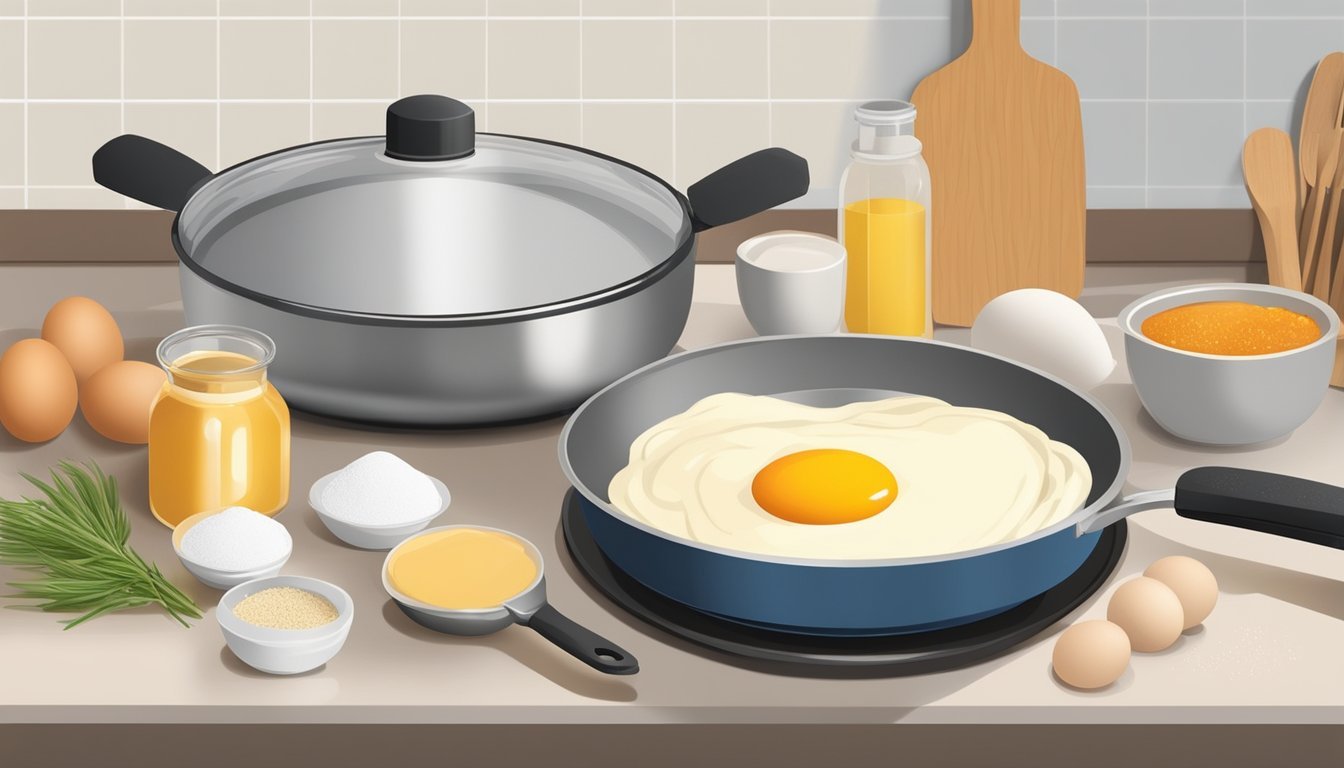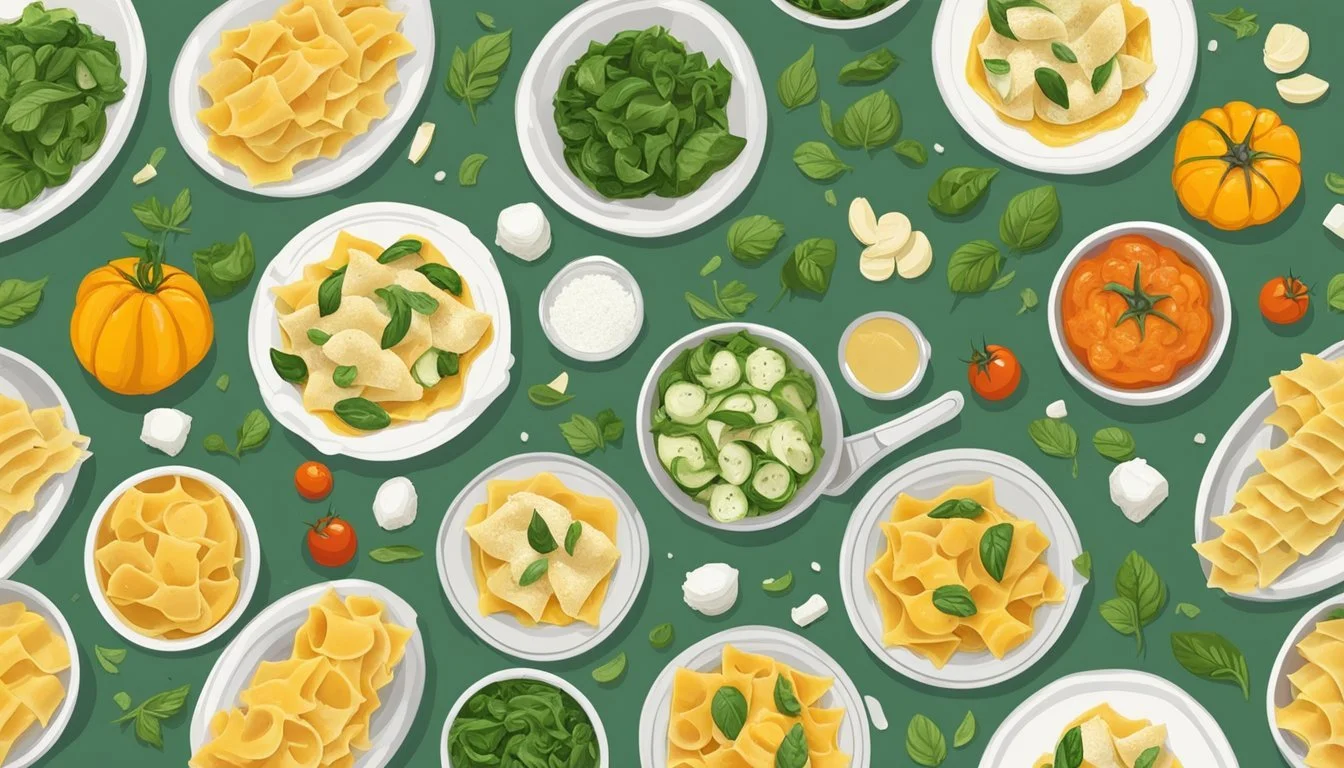Ravioli Pasta Substitutes
Top Alternatives for Your Favorite Filling
Ravioli stands as a classic Italian dish known for its pocket-like pasta (What wine goes well with pasta?) enclosing a variety of fillings, from cheese and meats to vegetables. However, those seeking alternative dietary choices, whether due to health restrictions, personal preferences, or a desire for more nutritious options, often explore ravioli pasta substitutes. These alternatives aim to mimic the texture and satisfaction one expects from traditional ravioli while offering different nutritional profiles that may align better with certain health goals.
Substitutes for ravioli pasta are not only diverse in ingredients but also in their health benefits. Ingredients such as spiralized vegetables, legume-based pastas, and grain alternatives like quinoa (What wine goes well with quinoa?) provide a lower-carb and often gluten-free alternative to traditional ravioli. These substitutes not only cater to the needs of those with food sensitivities but also contribute to an overall balanced diet by providing additional fiber, vitamins, and sometimes even protein, depending on the substitute chosen.
The market's expansion of pasta substitutes has made it easier for individuals to make healthier choices without drastically sacrificing the flavors they love. Substitutes such as zucchini noodles, known as zoodles, and other spiralized vegetables, integrate seamlessly into dishes that originally call for ravioli. This versatility ensures that the essence of the dish remains, offering a familiar palate with enhanced nutritional benefits.
Understanding Pasta Substitutes
In an effort to accommodate various dietary needs and preferences, the array of pasta substitutes has expanded, offering benefits like lower carb content and enhanced nutritional value.
Types of Pasta Alternatives
Pasta alternatives vary widely in ingredients and texture, providing options for those on ketogenic diets, with gluten intolerances, or simply seeking a healthier profile in their meals. The following list outlines common pasta substitutes:
Chickpea Pasta: Rich in protein and fiber, chickpea pasta is gluten-free and a great source of vitamins and minerals.
Brown Rice Pasta: Offers a similar texture to traditional pasta but is gluten-free, with a moderate amount of protein.
Whole Wheat Pasta: Contains more fiber and protein than white pasta, supporting weight management while being high in antioxidants.
Shirataki Noodles: Comprising largely water and glucomannan, a type of fiber, these are extremely low in calories and carbs, fitting well within a keto diet.
Kelp Noodles: Low in calories and carbs, these are suitable for those looking to reduce calorie intake without sacrificing volume.
Nutritional Advantages of Substitutes
Pasta substitutes can offer several nutritional benefits over traditional pasta. They frequently have:
Reduced Caloric Intake: Many substitutes are lower in calories, aiding in weight loss efforts.
Lower Carbohydrate Content: Ideal for low-carb and keto diets, alternatives like shirataki noodles dramatically reduce carb intake.
Increased Fiber: Options like chickpea and whole wheat pasta have higher fiber content, which can improve digestive health.
Enriched with Protein: Substitutes often boast increased protein levels, essential for muscle repair and satiety.
Rich in Vitamins: Many pasta alternatives are fortified with vitamins or naturally contain them, alongside antioxidants that support overall health.
Vegetable-Based Substitutes
Vegetable-based substitutes for ravioli pasta are gaining popularity for those seeking low-carb alternatives or wanting to increase their vegetable intake. They not only provide a semblance of the texture one expects from traditional pasta but also offer a way to integrate more vegetables into meals.
Zucchini Noodles
Zucchini noodles, or "zoodles," are a well-known substitute for pasta. They are made by spiralizing zucchini into thin strands, resembling the shape of noodles. Zoodles are particularly versatile and can be prepared by sautéing briefly to retain their crispness. Their neutral flavor pairs well with a variety of sauces, making them an excellent option for replacing ravioli sheets.
Spaghetti Squash Options
Spaghetti squash generates strands that mimic the style of spaghetti noodles when cooked and scraped with a fork. For a ravioli substitute, the flesh of spaghetti squash can be used as a bed for traditional fillings and sauces. It is a nutritious choice, as it's high in vitamins and minerals, yet low in calories.
Cooking method:
Cut in half, seed, and bake flesh-side down with a bit of water.
Once tender, scrape with a fork to create noodles.
Cauliflower Innovations
Cauliflower can be transformed into various pasta-like alternatives. When grated and cooked, it can take on the texture that complements the rich fillings of ravioli. Its mild flavor allows the taste of accompanying sauces and seasonings to stand out, without the high carbohydrate content of regular pasta.
Advantages:
Low carbohydrate content
Blends well with a wide range of flavors
Other Vegetable Options
Other vegetables such as carrots, beets, and butternut squash can also be spiralized to create noodle-like strands. These substitutes are not only colorful but also bring their own unique flavors and textures to the dish, adding a new dimension to the ravioli experience.
Sample vegetables for spiralizing:
Carrot
Beets
Butternut squash
Each of these vegetables provides a nutritious twist to the traditional ravioli, adding both visual appeal and a diverse pallete of flavors to any meal.
Legume and Grain Alternatives
When searching for ravioli pasta substitutes, one can consider various legume and grain-based alternatives that offer a balance of flavor and nutrition. These substitutes are not only great for those looking for gluten-free or low-carb options but also enrich the diet with protein and fiber.
Quinoa Options
Quinoa, a highly nutritious grain, serves as an excellent base for pasta alternatives. Quinoa ravioli shells provide a chewy texture and a subtle, nutty flavor. They are a rich source of protein and contain all nine essential amino acids, making them a complete protein choice for vegetarians and vegans. Quinoa pasta alternatives are also naturally gluten-free, suiting those with gluten sensitivities.
Protein: High
Gluten Content: None
Chickpea and Lentil Varieties
Chickpea pasta and lentil-based substitutes stand out as legume options that boast high levels of protein and fiber. These varieties often mimic the texture of traditional ravioli and support a feeling of fullness. They are ideal for individuals seeking low-carb pasta options with a lower glycemic index, contributing to better blood sugar control.
Protein: High
Fiber: High
Rice Alternatives
Among grain substitutes, rice noodles and brown rice pasta shapes can be reworked to fill the role of ravioli. While offering a softer texture, these alternatives are beneficial for those who prefer a gluten-free diet. Compared to traditional pasta, rice-based raviolis tend to be lighter and are often used in Asian-inspired dishes.
Texture: Softer
Gluten Content: None
Unique Pasta Substitutes
In the pursuit of dietary variety or constraints, pasta lovers often seek out unconventional alternatives that provide similar satisfaction and versatility. This selection delves into novel options, each bringing a distinctive texture and flavor to the table.
Shirataki Noodles and Sea Vegetables
Shirataki Noodles: Made from the konjac plant, shirataki noodles are low in calories and carbohydrates. They are translucent and gelatinous and can be an excellent substitute for ravioli in soups or with sauces that have a robust flavor profile.
Kelp Noodles: As a sea vegetable, kelp noodles offer a mineral-rich, gluten-free alternative to traditional pasta. They work well in cold dishes similar to pasta salads and can emulate some of the texture of traditional noodles when softened in liquid.
Eggplant and Root Vegetables
Eggplant: When sliced thinly and layered, eggplant can stand in for pasta sheets in dishes like lasagna. It offers a meaty texture and absorbs flavors well, making it a suitable carrier for various sauces.
Sweet Potatoes: Spiralized sweet potatoes, or 'swoodles,' are a colorful, nutrient-dense substitute for noodles. They should be cooked just enough to remain tender yet hold their shape, making them a fitting choice particularly for more structured dishes.
Specialty Grain Substitutes
Farro and Barley: These ancient grains can be used in lieu of pasta for their chewy texture and nutty flavor. They are best suited for pasta salads or as a base in grain bowls.
Couscous: While smaller in size, couscous can replace orzo or other small pasta shapes. It is exceptionally versatile, easily adapting to various sauces and seasonings in hot or cold recipes.
Gluten-Free and Low-Carb Alternatives
For individuals managing conditions like celiac disease or diabetes, or those following a low-carb or ketogenic diet, finding suitable ravioli pasta substitutes that cater to their dietary needs is crucial. The market offers gluten-free pasta made from various grains, as well as low-carb options that minimize carbohydrate intake.
Gluten-Free Pasta Options
Gluten-free pasta alternatives are often made from rice, corn, or a blend of gluten-free grains.
Brown Rice Pasta: A popular gluten-free substitute, brown rice pasta offers a taste and texture similar to traditional wheat pasta. Brands like Jovial and Tinkyada specialize in this type of pasta.
Quinoa Pasta: Made from quinoa flour, this option is rich in protein and a good gluten-free alternative.
Cooking tip: Gluten-free pasta should be cooked in boiling water until al dente, and a splash of olive oil can be added to the cooking water to prevent sticking.
Keto-Friendly Choices
For those on a ketogenic diet or seeking lower carbohydrate options, there are pastas made from ingredients such as:
Shirataki Noodles: These noodles are made from a fiber called glucomannan, derived from the konjac root, making them extremely low in carbs.
Vegetable Noodles: Spiralized vegetables like zucchini and carrots provide a low-carb alternative that can be quickly cooked or eaten raw. They can be seasoned with ingredients like sesame for added flavor.
Tip: When preparing low-carb pasta alternatives, be mindful of the sauces and additions like cheese, which can add extra carbs.
Dressings and Sauces for Substitutes
Choosing the right dressing or sauce can transform a ravioli dish, enhancing the flavors and complementing the texture of the pasta substitute chosen. Below are focused recommendations for cheese and butter sauces as well as vegetable and herb-infused sauces, tailored to bring out the best in ravioli substitutes.
Cheese and Butter Sauces
Parmesan Cream Sauce:
Ingredients: heavy cream, grated Parmesan cheese, garlic, butter.
Method: Melt butter with minced garlic, add cream, and simmer. Stir in Parmesan until smooth.
Ingredients: Ricotta cheese, fresh sage, butter.
Method: Melt butter, add sage leaves until crispy, blend in ricotta until warm
These sauces deliver a rich texture and deep flavors, suitable for pasta substitutes that have a neutral taste, allowing the cheese's creaminess and the butter's richness to shine through.
Vegetable and Herb-Infused Sauces
Basil Pesto:
Ingredients: Fresh basil, garlic, pine nuts, Parmesan cheese, olive oil.
Preparation: Pulse all ingredients in a food processor until smooth.
Garlic and Herb Oil:
Ingredients: Olive oil, a selection of herbs (basil, parsley, thyme), garlic.
Method: Gently heat olive oil with finely chopped herbs and minced garlic.
These sauces offer a fresh and light complement to ravioli substitutes, where the aromatic qualities of herbs and the pungency of garlic play a significant role in flavoring the dish. Olive oil provides a healthy, unobtrusive base that carries these flavors well.
Preparing and Cooking Pasta Substitutes
When seeking alternatives to traditional pasta, the approach to preparing and cooking these substitutes is crucial for achieving the desired texture and flavor. This section outlines various methods to prepare pasta substitutes, ensuring they can seamlessly integrate into your favorite dishes.
Spiralizing Techniques
A spiralizer is a handy tool for creating pasta-like strands from vegetables. Zucchini can be turned into "zoodles" as a pasta alternative using this device. When spiralizing, one should aim for uniform strands to ensure even cooking. After spiralizing, these vegetable noodles should be cooked for 1 to 2 minutes until just tender, and then promptly drained to prevent overcooking.
Roasting and Baking Methods
Substitutes such as sliced vegetables can be seasoned with olive oil, garlic, and herbs, and then roasted to enhance their flavor. For example, thinly sliced zucchini can be brushed with olive oil and roasted in an oven set at 425°F for 12 to 15 minutes. This method produces substitutes with a concentrated flavor that holds up well against robust sauces.
Boiling and Sautéing
Boiling is the most common method for cooking traditional pasta, and certain substitutes like rice noodles benefit from this method too. To ensure they maintain an al dente texture, rice noodles should be boiled for the time specified on the package, usually between 3 to 5 minutes. Sautéing in olive oil or garlic allows for a lightly crisped texture and is ideal for quick-cooking substitutes such as shirataki noodles, which only need to be warmed through.
Health Considerations and Benefits
When looking for ravioli pasta substitutes, one must consider their nutritional value, how they can aid in weight management, and their suitability for special diets. They offer a balance between satisfying pasta cravings and maintaining a health-conscious lifestyle.
Nutritional Value Insights
Ravioli substitutes, such as zucchini noodles or brown rice pasta, offer distinct nutritional profiles. For instance, zucchini noodles are rich in vitamin C, potassium, and antioxidants, but lower in carbs and calories. Brown rice pasta, on the other hand, provides more fiber compared to traditional pasta, benefiting digestive health.
Zucchini Noodles: High in nutrients, low in calories.
Brown Rice Pasta: Higher in fiber, good for digestion.
Impact on Weight Management
Low-carb pasta alternatives are valuable for weight loss efforts as they typically contain fewer calories than traditional pasta. Weight loss can be easier with these substitutes because they help maintain a feeling of fullness with a lower calorie intake, making it simpler for individuals to stick to a calorie-deficit diet.
Calorie Content: Substitutes often have fewer calories per serving.
Satiety: High-fiber options contribute to a feeling of fullness.
Suitability for Special Diets
Substitutes for ravioli pasta cater to a variety of dietary needs. Those following a keto diet may find shirataki noodles convenient due to their low carbohydrate content. For individuals with diabetes, alternatives like brown rice pasta have a lower glycemic index, assisting in blood sugar management. Additionally, whole grain pasta options can be an excellent source of nutrition and are sometimes considered to align with dietary approaches aimed at cancer prevention.
Diabetic-Friendly: Lower glycemic options are available.
Keto-Compatible: Options like shirataki noodles fit well within a ketogenic framework.
Recipe Ideas
Ravioli, a cherished Italian pasta, lends itself well to a range of creative culinary adaptations. Rest assured, these recipes ensure that the rich flavors and satisfying textures remain center stage.
Appetizers and Side Dishes
One can kick off a meal with Ravioli Appetizers featuring deep-fried ravioli served with a spicy marinara dipping sauce. For a twist, they might also stuff the ravioli with a blend of ricotta cheese and finely chopped spinach. Additionally, Ravioli Skewers can act as an enticing side, where pieces of ravioli, alternated with cherry tomatoes and peppers, are grilled to perfection and brushed with garlic-infused olive oil.
Ingredients: Cheese ravioli, bread crumbs, parmesan, eggs, oil for frying
Instructions: Coat ravioli in egg, then breadcrumbs mixed with parmesan; fry until golden.
Ravioli Skewers:
Ingredients: Ravioli, cherry tomatoes, bell peppers, olive oil, garlic
Instructions: Skewer cooked ravioli with tomatoes and peppers; grill and baste with garlic oil.
Main Course Innovations
For the main course, chefs can craft a Savory Ravioli Bake by layering cheese ravioli with a protein-packed meat sauce made from ground beef, mushrooms, and a cheesy sauce, topped with mozzarella. Alternatively, a lighter yet no less flavorful option could be a fusion dish like Ravioli Stir Fry, where ravioli replaces traditional egg noodles, combined with a mix of tofu, cabbage, and a hint of sugar for sweetness, all tossed in a tangy soy-based sauce.
Savory Ravioli Bake:
Base: Cheese ravioli
Protein: Ground beef, mushrooms
Sauces: Tomato sauce, cheesy sauce
Instructions: Layer cooked ravioli with sauces and beef, top with cheese, and bake.
Ravioli Stir Fry:
Protein: Tofu, diced
Vegetables: Cabbage, sliced bell peppers, mushrooms
Sauce: Soy sauce, sugar, garlic
Instructions: Stir-fry tofu and vegetables, add cooked ravioli and sauce to combine.
Conclusion
Exploring pasta alternatives presents an array of choices for those seeking variation in flavor, texture, and nutritional value. Each option offers a unique profile that might suit different dietary preferences and health objectives. Traditional pasta, while a staple in many diets, may not align with everyone's nutritional goals. Pasta alternatives can often provide enhanced health benefits, such as increased fiber, reduced calorie count, and a lower glycemic index.
For those concerned with health aspects, alternatives like brown rice pasta and quinoa supply valuable nutrients. Brown rice pasta, for example, is a good source of whole grains and is naturally gluten-free. Quinoa is not only an excellent pasta substitute but also a protein powerhouse with all nine essential amino acids.
Below are select pasta substitutes and their corresponding attributes:
Alternative Key Benefits Spiralized Vegetables Low in calories, high in vitamins Kelp Noodles Rich in minerals, low in carbs Shirataki Noodles Calorie-free, fiber-rich Quinoa High in protein, gluten-free Brown Rice Pasta Whole grain, suitable for gluten intolerance
In creating pasta-like experiences, one doesn't have to forsake flavor for nutrition. Incorporating these substitutes into meals can often meet the culinary needs of various diets—from gluten-free to high-protein—while still delivering on taste. Consumers should consider their personal dietary requirements and culinary preferences to select the most appropriate pasta alternative.

